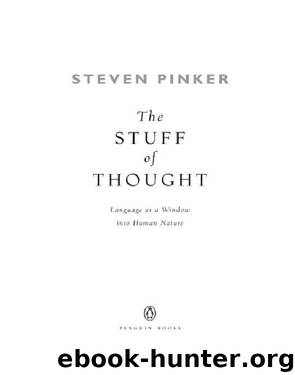The Stuff of Thought by Steven Pinker

Author:Steven Pinker
Language: eng
Format: mobi, epub
Publisher: Penguin USA, Inc.
Published: 2011-02-15T10:00:00+00:00
BENEATH THE METAPHOR
If learning and using a metaphor requires us to manipulate ideas in a deeper stratum of thought, do we have any idea what these ideas are? One can glimpse them in a more moderate version of the theory of conceptual metaphor originally discovered by Lakoff’s MIT classmate Jeffrey Gruber and developed by another alumnus, Ray Jackendoff.38
The key phenomenon was introduced in chapter 2: verbs like go, be, and keep are used not just for location (The doctor kept Pedro at home) but also for states (The doctor kept Pedro healthy), possessions (Pedro kept the house), and times (Pedro kept the practice session at noon). Jackendoff noted that these verbs preserve one part of their meaning across the physical and nonphysical uses, but not other parts. The preserved part is a skeleton of spatial and force-dynamic concepts like those explored in chapters 2 and 4: thing, substance, aggregate, place, path, agonist, antagonist, goal, means. The skeleton is then labeled with a symbol for a semantic field, such as location, state, possession, or time. For example, the skeleton behind keep in He kept the money might specify an antagonist opposing an agonist’s tendency to go away, with a label slapped across it that says “possession.” The concept behind keep in He kept the book on the shelf would have the same skeleton but would bear the label “location.”
The metaphorical flavor of language comes from the fact that skeletal concepts like “go,” “place,” and “agonist” maintain connections to physical reasoning. They are most easily triggered by the experience of seeing things move around; they are used by children in spatial senses before they are used in abstract senses; and they might have evolved from circuitry for physical reasoning in our primate ancestors. Yet as they take part in moment-to-moment thinking, they are abstract symbols, and need not drag with them images of hunks of matter rolling around. For that reason they are not genuinely metaphorical, at least not in Lakoff’s sense.
At this point one might ask: If the concepts beneath a conceptual metaphor are ultimately just abstract symbols like x, y, and z, in what sense would any notion of metaphor have a role in the adult mind? And why, in the course of history, development, or evolution, would the mental machinery for location be co-opted for possession, circumstance, or time, if they just get bleached of any content having to do with real space?
The answer is that there are tools of inference that can be carried over from the physical to the nonphysical realms, where they can do real work. For example, it’s in the nature of space, time, and causation that if A moves B over to C, then B was at not at C at a previous time, though now it is. It’s also true that if A had not done the moving, B would not now be at C. Crucially, the same syllogisms apply in the realm of possession. If A gives B to C, then B was not owned by C at a previous time, though now it is.
Download
This site does not store any files on its server. We only index and link to content provided by other sites. Please contact the content providers to delete copyright contents if any and email us, we'll remove relevant links or contents immediately.
Rewire Your Anxious Brain by Catherine M. Pittman(18551)
Talking to Strangers by Malcolm Gladwell(13222)
The Art of Thinking Clearly by Rolf Dobelli(10214)
Mindhunter: Inside the FBI's Elite Serial Crime Unit by John E. Douglas & Mark Olshaker(9190)
Becoming Supernatural by Dr. Joe Dispenza(8119)
Change Your Questions, Change Your Life by Marilee Adams(7634)
Nudge - Improving Decisions about Health, Wealth, and Happiness by Thaler Sunstein(7615)
The Road Less Traveled by M. Scott Peck(7522)
The Lost Art of Listening by Michael P. Nichols(7403)
Enlightenment Now: The Case for Reason, Science, Humanism, and Progress by Steven Pinker(7228)
Mastermind: How to Think Like Sherlock Holmes by Maria Konnikova(7224)
Win Bigly by Scott Adams(7094)
The Way of Zen by Alan W. Watts(6504)
Daring Greatly by Brene Brown(6444)
Big Magic: Creative Living Beyond Fear by Elizabeth Gilbert(5610)
Grit by Angela Duckworth(5515)
Ego Is the Enemy by Ryan Holiday(5292)
Men In Love by Nancy Friday(5155)
Altered Sensations by David Pantalony(5043)
